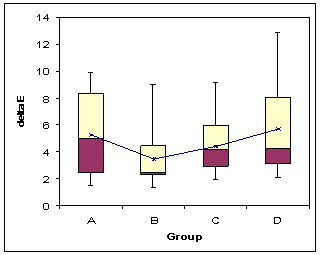ABSTRACT: 0650
Veneer Resin Cement Color Stability After Thermal Cycling in Vitro
| J. LACOURSE, Tufts University, boston, MA, USA, R. PERRY, Tufts University, Boston, MA, USA, J. ORFANIDIS, Orfan Dental Laboratory Inc, South Weymouth, MA, USA, and J.M. POWERS, Dental Consultants, Inc, Ann Arbor, MI, USA |
Objective: Evaluate the color change of four light cured resin luting cements under porcelain discs. Methods: Forty human extracted teeth were divided into 4 groups (N=10): Group A: Calibra Esthetic Resin Cement Base (Dentsply); color “Light” Group B: RelyX Veneer Cement (3M ESPE); color “B0.5/White” Group C: NX3 Nexus Third Generation (Kerr Dental); color “White” Group D: Variolink Veneer (Ivoclar Vivadent); color “High Value +1” The samples were in acrylic and the crowns were cut flat to expose the highest amount of dentin. The samples were sanded with a 240 grit for 30 sec/30 rpm Each sample was etched, primed and bonded (according to each manufacturer's guidelines) and then a 2x5mm porcelain disc was cemented onto each sample. The samples were light cured with the Dentsply halogen QHL75 curing light and were thermocycled for 900 hundred cycles between 5°C and 55°C with a dwell time of 30 seconds. Prior to and after thermo cycling L*a*b scores were taken by the Vita Easyshade probe, a Vita classical shade and 3D color shade. The samples were stored in distilled water at 37°C. Results:
The ΔE averages for the ten samples of each cement group, Group B had the lowest ΔE with 3.6 followed by Group C (4.4), Group A (5.3) and Group D (5.6). There was no correlation between the ΔE of each group compared to the VitaShade classical and 3D shade guide differences. One way analysis of ANOVA, and Fishers PLSD demonstrated no significant difference between the ΔE of each sample group. When examined with the untrained, human eye, there was no color difference noticed. Conclusion: There was no statistical color change in any of the resin cement sample groups; making these materials clinically acceptable for use in porcelain veneers. Sponsored in part by Dentsply Caulk
|
| Seq #107 - Ceramics, Cements, and Bonding 1:30 PM-2:30 PM, Friday, April 4, 2008 Hilton Anatole Hotel Trinity I - Exhibit Hall |
|
Back to the Dental Materials 3: Ceramic-based Materials and Cements Program |
©Copyright 2008 American Association for Dental Research. All Rights Reserved.
